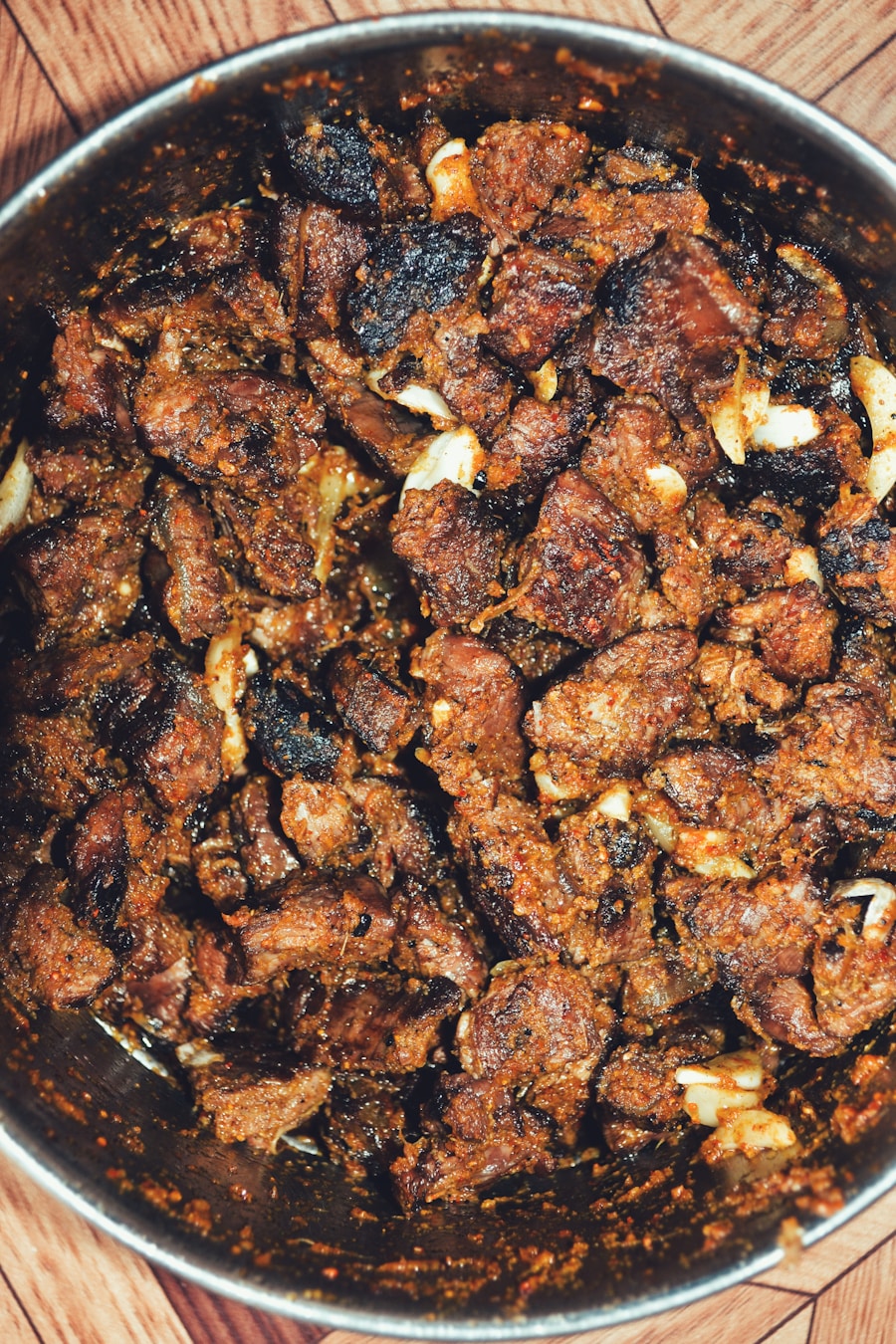The Ultimate Guide to Perfect Adobo
Description
Adobo, a dish that has become synonymous with Filipino cuisine, boasts a rich and complex history that reflects the diverse cultural influences that have shaped the Philippines over centuries. The term “adobo” is derived from the Spanish word “adobar,” which means “to marinate.” This connection to Spanish colonialism is significant, as it was during the 16th century that the Spanish colonizers introduced their culinary practices to the archipelago. However, the roots of adobo extend far beyond this colonial influence, as indigenous cooking methods and local ingredients played a crucial role in its evolution.
Before the arrival of the Spanish, Filipinos were already adept at preserving food through various methods, including fermentation and drying. The use of vinegar, soy sauce, and spices in cooking was prevalent among indigenous communities. When the Spanish introduced their own techniques and ingredients, such as garlic and bay leaves, a unique fusion emerged.
This melding of flavors and methods gave rise to the adobo we know today, characterized by its savory, tangy, and slightly sweet profile.
Key Takeaways
- Adobo has a long history in Filipino cuisine, with its roots in the Spanish colonial era and influences from indigenous cooking methods.
- The key ingredients for the perfect adobo include vinegar, soy sauce, garlic, bay leaves, and black peppercorns.
- Cooking techniques for adobo involve marinating the meat in the sauce before simmering it to tender perfection.
- Variations of adobo can include different types of meat such as chicken, pork, or even seafood, as well as regional variations in the Philippines.
- Adobo can be served with steamed rice, pickled vegetables, or alongside other Filipino dishes such as pancit or lumpia.
Ingredients for the Perfect Adobo
Creating the perfect adobo begins with selecting high-quality ingredients that contribute to its signature flavor. The primary components typically include meat—commonly chicken or pork—but variations can also incorporate beef, seafood, or even vegetables for a vegetarian option. The choice of meat significantly influences the dish’s overall taste and texture; for instance, chicken thighs are often preferred for their juiciness and ability to absorb flavors better than leaner cuts.
The marinade is where the magic happens. A traditional adobo marinade consists of soy sauce, vinegar, garlic, bay leaves, and black peppercorns. The balance between vinegar and soy sauce is crucial; too much vinegar can overpower the dish, while too little may result in a lack of depth.
Many cooks also add sugar or coconut milk to create a more complex flavor profile. Fresh ingredients are essential; using freshly crushed garlic rather than pre-minced or powdered forms can elevate the dish significantly. Additionally, incorporating local varieties of vinegar—such as cane vinegar or coconut vinegar—can impart unique regional flavors that enhance the authenticity of the dish.
Cooking Techniques for Adobo

The cooking techniques employed in preparing adobo are as varied as its ingredients. The most traditional method involves marinating the meat in a mixture of soy sauce, vinegar, garlic, and spices for several hours or overnight. This step not only infuses the meat with flavor but also helps tenderize it.
Variations of Adobo
| Adobo Variation | Main Ingredients | Region |
|---|---|---|
| Adobo sa Gata | Chicken, pork, or seafood cooked in coconut milk | Philippines |
| Adobo with Pineapple | Chicken or pork with pineapple chunks | Philippines |
| Adobong Pusit | Squid cooked in soy sauce, vinegar, and garlic | Philippines |
| Adobo Blanco | Chicken or pork cooked without soy sauce | Philippines |
Adobo is not a monolithic dish; it has numerous regional variations that reflect local ingredients and culinary traditions. One notable variation is “adobo sa gata,” which incorporates coconut milk into the sauce, resulting in a creamier texture and a slightly sweet flavor profile.
The addition of chili peppers can also introduce a delightful heat that complements the richness of the coconut milk. Another variation is “adobong puti,” which translates to “white adobo.” Unlike traditional adobo that relies heavily on soy sauce for color and flavor, adobong puti uses only vinegar and salt for seasoning. This results in a lighter-colored dish that highlights the natural flavors of the meat without overpowering it with dark soy sauce.
In contrast, “adobong mani” features peanuts as a key ingredient, adding a nutty richness that sets it apart from more conventional versions. Each variation tells a story about its region’s agricultural practices and cultural influences, showcasing how adobo has adapted over time.
Serving Suggestions for Adobo
Adobo is often served with steamed white rice, which acts as a perfect canvas for soaking up the flavorful sauce. The combination of tender meat and tangy sauce against fluffy rice creates a comforting meal that resonates with many Filipinos. For an added layer of texture and flavor, some people enjoy pairing adobo with pickled vegetables or a side salad to balance out the richness of the dish.
In addition to rice, adobo can be creatively incorporated into other dishes. For instance, leftover adobo can be shredded and used as a filling for tacos or sandwiches, offering a fusion twist on traditional Filipino flavors. Some chefs even experiment by using adobo as a base for pasta dishes or pizza toppings, showcasing its versatility beyond its original context.
These innovative serving suggestions highlight how adobo can transcend cultural boundaries while still retaining its essence.
Tips for Perfecting Your Adobo

To achieve an exceptional adobo at home, several tips can help elevate your cooking game. First and foremost is the marination process; allowing your meat to marinate for an extended period—ideally overnight—will yield more flavorful results. If time is limited, even a few hours can make a difference, but patience pays off when it comes to developing depth in flavor.
Another crucial aspect is balancing acidity and saltiness. Experimenting with different types of vinegar can lead to delightful discoveries; for example, using apple cider vinegar may impart a milder tang compared to traditional cane vinegar. Additionally, consider adjusting the amount of soy sauce based on your taste preferences or dietary restrictions—low-sodium soy sauce can be an excellent alternative for those watching their salt intake.
Finally, don’t shy away from personalizing your adobo with additional spices or ingredients that resonate with your palate. Whether it’s adding chili flakes for heat or incorporating vegetables like potatoes or hard-boiled eggs for added substance, these small adjustments can transform your dish into something uniquely yours while still honoring the traditional roots of adobo.
FAQs
What is Adobo?
Adobo is a popular Filipino dish that involves marinating meat, seafood, or vegetables in a mixture of vinegar, soy sauce, garlic, and other seasonings, then simmering it until tender.
What are the main ingredients in Adobo?
The main ingredients in Adobo typically include vinegar, soy sauce, garlic, bay leaves, and black peppercorns. The dish can be made with various proteins such as chicken, pork, beef, or seafood.
How is Adobo cooked?
To cook Adobo, the meat or other main ingredient is marinated in the vinegar and soy sauce mixture, then simmered in the marinade along with the other seasonings until it is tender and flavorful.
What is the origin of Adobo?
Adobo is a traditional Filipino dish that has its roots in Spanish cuisine. The cooking method of marinating and stewing meat in vinegar and spices was introduced by the Spanish during their colonization of the Philippines.
What are the variations of Adobo?
There are many regional and personal variations of Adobo in the Philippines. Some variations include using coconut milk, adding sugar for a sweeter flavor, or using different types of protein such as fish or vegetables.





